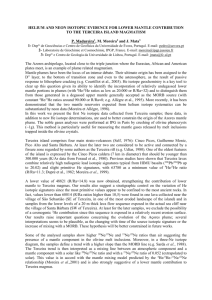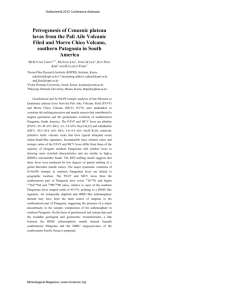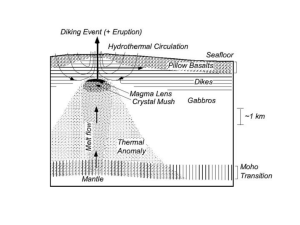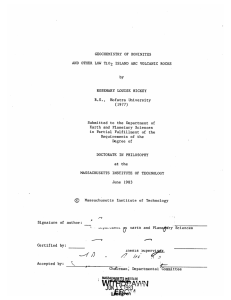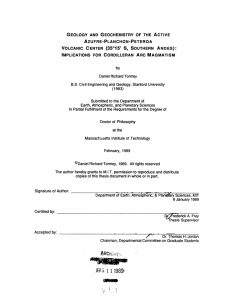CNG2006
advertisement
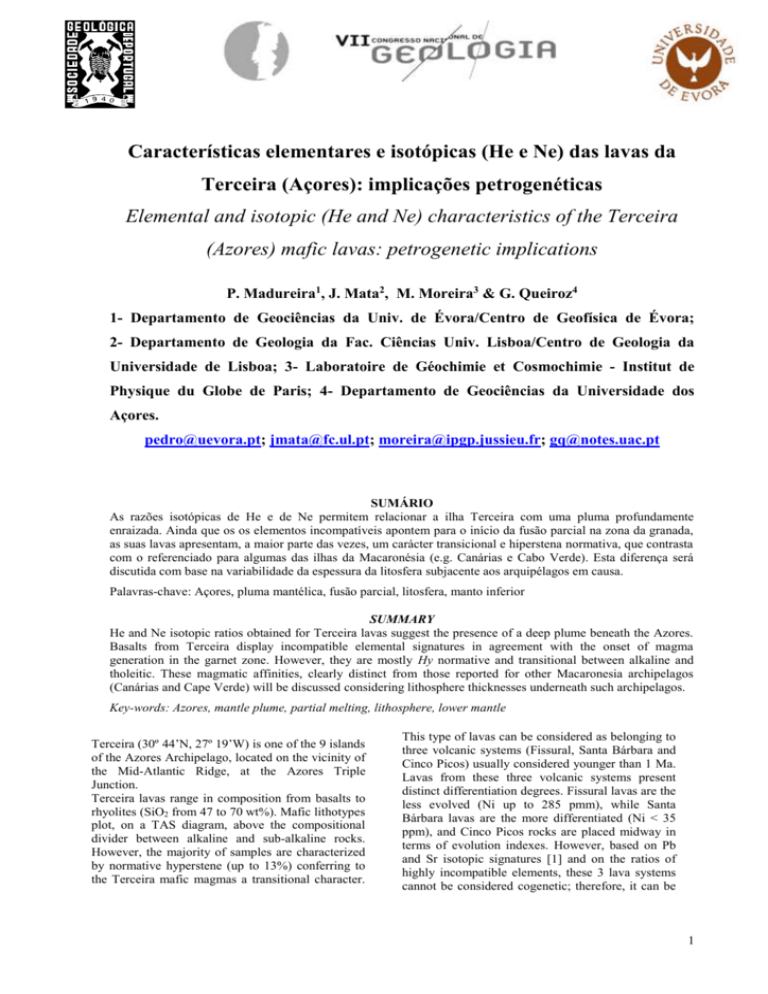
Características elementares e isotópicas (He e Ne) das lavas da Terceira (Açores): implicações petrogenéticas Elemental and isotopic (He and Ne) characteristics of the Terceira (Azores) mafic lavas: petrogenetic implications P. Madureira1, J. Mata2, M. Moreira3 & G. Queiroz4 1- Departamento de Geociências da Univ. de Évora/Centro de Geofísica de Évora; 2- Departamento de Geologia da Fac. Ciências Univ. Lisboa/Centro de Geologia da Universidade de Lisboa; 3- Laboratoire de Géochimie et Cosmochimie - Institut de Physique du Globe de Paris; 4- Departamento de Geociências da Universidade dos Açores. pedro@uevora.pt; jmata@fc.ul.pt; moreira@ipgp.jussieu.fr; gq@notes.uac.pt SUMÁRIO As razões isotópicas de He e de Ne permitem relacionar a ilha Terceira com uma pluma profundamente enraizada. Ainda que os os elementos incompatíveis apontem para o início da fusão parcial na zona da granada, as suas lavas apresentam, a maior parte das vezes, um carácter transicional e hiperstena normativa, que contrasta com o referenciado para algumas das ilhas da Macaronésia (e.g. Canárias e Cabo Verde). Esta diferença será discutida com base na variabilidade da espessura da litosfera subjacente aos arquipélagos em causa. Palavras-chave: Açores, pluma mantélica, fusão parcial, litosfera, manto inferior SUMMARY He and Ne isotopic ratios obtained for Terceira lavas suggest the presence of a deep plume beneath the Azores. Basalts from Terceira display incompatible elemental signatures in agreement with the onset of magma generation in the garnet zone. However, they are mostly Hy normative and transitional between alkaline and tholeitic. These magmatic affinities, clearly distinct from those reported for other Macaronesia archipelagos (Canárias and Cape Verde) will be discussed considering lithosphere thicknesses underneath such archipelagos. Key-words: Azores, mantle plume, partial melting, lithosphere, lower mantle Terceira (30º 44’N, 27º 19’W) is one of the 9 islands of the Azores Archipelago, located on the vicinity of the Mid-Atlantic Ridge, at the Azores Triple Junction. Terceira lavas range in composition from basalts to rhyolites (SiO2 from 47 to 70 wt%). Mafic lithotypes plot, on a TAS diagram, above the compositional divider between alkaline and sub-alkaline rocks. However, the majority of samples are characterized by normative hyperstene (up to 13%) conferring to the Terceira mafic magmas a transitional character. This type of lavas can be considered as belonging to three volcanic systems (Fissural, Santa Bárbara and Cinco Picos) usually considered younger than 1 Ma. Lavas from these three volcanic systems present distinct differentiation degrees. Fissural lavas are the less evolved (Ni up to 285 pmm), while Santa Bárbara lavas are the more differentiated (Ni < 35 ppm), and Cinco Picos rocks are placed midway in terms of evolution indexes. However, based on Pb and Sr isotopic signatures [1] and on the ratios of highly incompatible elements, these 3 lava systems cannot be considered cogenetic; therefore, it can be 1 concluded that they have evolved from primary magmas formed from mantle sources compositionally distinct. Lavas from each of these three systems present a significant compositional range, which is compatible with the occurrence of intra-system crystal fractionation processes, which were more important inside the Fissural (F = 0.41) and Santa Bárbara (F= 0.47) systems. For the Fissural system the compositional range can be successfully modeled considering the crystal fractionation of clinopyroxene, olivine and plagioclase in the proportion 0.50:0.45:0.05. For Sta Bárbara, clinopyroxene, plagioclase and Fe-Ti oxides dominate the differentiation process (0.5:0.4:0.1). The noticeably evolved character of the Sta Bárbara lavas indicates the existence of magma chamber(s) volumetrically significant. Geobarometric data suggest the location of these chamber(s) at Moho depths, which may have constituted a density compensation level. The fractionated rare earth patterns [(La/Yb)n = 711] and the low concentrations of Yb and Lu (1.92.7 and 0.25-0.37 respectively) points to the presence of garnet as a residual phase. However, this is at odds with the depth of magmatic segregation inferred from major elements, which is estimated at about 50-60 km, i.e. inside the spinel zone. This apparent paradox is the result of a relatively young (20 Ma) and thin lithosphere (probably less than 50 km) which allowed that melting of the ascending plume, initiated at depths where garnet is the stable aluminous phase, continued at the spinel zone. Magmas issued from the garnet zone by smaller melting degree, and hence highly rare-earth fractionated, mixed with more voluminous (higher F) and less enriched melts generated in equilibrium with spinel lherzolite. This would also explain the transitional affinities of Terceira Lavas as compared with the, sometimes, highly undersaturated lavas from other Macaronesia archipelagos where lithosphere is around 100 km thick, thus restraining plume melting to depths where garnet is stable. During their translithospheric ascent magmas interacted with the lithosphere as is strongly suggested by the evidences for equilibrium with amphibole, a phase not stable at asthenosphere or plume temperatures [e.g. 2]. The noble gas data (He and Ne) enable us to unequivocally demonstrate the contribution of an unradiogenic and undegassed reservoir [see also 3]. This reservoir with relatively primitive signatures [(21Ne/22Ne)corr = 0.0052 and 4He/3He > 9), is usually assigned to the lower mantle [e.g. 4]. These data are compatible with seismic tomagraphic studies [5; 6]. and the experimental work developed by [7]. Acknowledgements This a contribution from the FCT project STAMINA (PDCTM1999MAR15255). Subsidiary we were also financed by Centro de Geofísica Évora and Centro de Geologia da Universidade de Lisboa. References [1] Dupré, B., Lambret, B., Allégre, C. J. (1982). Isotopic variations within a single oceanic island: the Terceira case. Nature, 299: 620-622. [2] Class, C., Goldstein, S. L. (1997). Plume litosphere interaction in the ocean basins: constraints from the source mineralogy. Earth Planet. Sci. Lett., 150: 245-260. [3] Madureira, P., Moreira, M., Mata, J., Allègre, C. (2005). Primitive helium and neon isotopes in Terceira island: Constraints on the origin of the Azores archipelago. Earth Planet. Sci. Lett., 233:429-440. [4] Moreira, M., Allègre, C.J. (1998). Helium - Neon systematics and the structure of the mantle. Chem. Geol., 147: 53-59. [5] Montelli, R., Nolet, G., Dahlen, F.A., Masters, G., Engdahl, E. R., Hung, S-H. (2004). Finite-frequency tomografy reveals a variety of plumes in the mantle. Science, 303: 338-343. [6] Silveira, G.; Stutzmann,E.; Davaille,A.; Montagner, J.P.;Mendes-Victor, L., Sebai, A. (em imp.). Azores hotspot signature in the upper mantle. J. Volcanol. Geotherm. Res. [7] Davaille, A., Vatteville, J. (2005). On The transient nature of mantle plumes. Geophys. Res. Lett., vol.32, L14309, doi:10.1029/2005GL023029. 2 3
